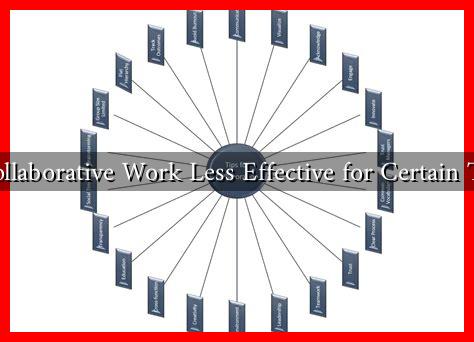-
Table of Contents
Is Collaborative Work Less Effective for Certain Tasks?
In today’s fast-paced work environment, collaboration has become a buzzword, often touted as the key to innovation and productivity. However, the effectiveness of collaborative work can vary significantly depending on the nature of the task at hand. This article explores the nuances of collaborative work, examining when it is beneficial and when it may hinder productivity.
The Nature of Collaborative Work
Collaborative work involves individuals coming together to achieve a common goal, leveraging diverse skills and perspectives. While this approach can lead to creative solutions and enhanced problem-solving, it is not universally effective. Understanding the types of tasks that benefit from collaboration versus those that do not is crucial for optimizing team performance.
Tasks That Benefit from Collaboration
Some tasks inherently lend themselves to collaborative efforts. These include:
- Complex Problem-Solving: Tasks that require diverse expertise, such as product development or strategic planning, often benefit from collaboration. For instance, a team of engineers, designers, and marketers can collectively brainstorm innovative solutions.
- Creative Projects: Collaborative environments can foster creativity. A study by the University of Michigan found that brainstorming in groups can lead to more innovative ideas compared to solitary work.
- Interdisciplinary Research: In fields like healthcare or environmental science, collaboration among specialists from different disciplines can yield comprehensive insights and solutions.
Tasks That May Suffer from Collaboration
Conversely, certain tasks may be less effective when approached collaboratively. These include:
- Routine or Repetitive Tasks: Tasks that require minimal cognitive effort, such as data entry or basic administrative duties, may be more efficiently completed individually.
- Highly Specialized Work: When a task demands specific expertise, collaboration can lead to confusion. For example, a software developer may work more efficiently alone when writing complex code.
- Time-Sensitive Decisions: In situations where quick decisions are crucial, such as crisis management, collaboration can slow down the process. A study published in the Journal of Business Research found that teams often take longer to reach decisions than individuals.
Case Studies and Statistics
Several case studies illustrate the varying effectiveness of collaborative work. For instance, a 2018 study by the Harvard Business Review found that while 86% of employees and executives cite lack of collaboration as a major cause of workplace failures, the same study revealed that 70% of employees feel more productive when working alone on specific tasks.
Additionally, a report from McKinsey & Company highlighted that teams that collaborate effectively can increase productivity by up to 25%. However, this increase is contingent on the nature of the tasks being performed. For example, teams working on creative projects saw a significant boost in productivity, while those engaged in routine tasks did not experience the same benefits.
Finding the Right Balance
To maximize productivity, organizations must find a balance between collaborative and individual work. Here are some strategies to consider:
- Task Assessment: Evaluate the nature of the task before deciding on a collaborative approach. Consider whether the task requires diverse input or if it can be completed more efficiently by an individual.
- Flexible Work Environments: Encourage a culture that allows for both collaborative and individual work. This flexibility can help employees choose the best approach for their specific tasks.
- Clear Communication: Establish clear goals and communication channels to ensure that collaboration is effective when it is employed.
Conclusion
While collaborative work can lead to innovative solutions and enhanced productivity in certain contexts, it is not a one-size-fits-all approach. Understanding the nature of the tasks at hand is essential for determining when collaboration is beneficial and when it may hinder efficiency. By assessing tasks, fostering flexible work environments, and promoting clear communication, organizations can harness the power of collaboration while also recognizing its limitations. Ultimately, the key to effective teamwork lies in striking the right balance between collaboration and individual effort.
For further reading on the impact of collaboration in the workplace, you can explore resources from the Harvard Business Review and McKinsey & Company.

